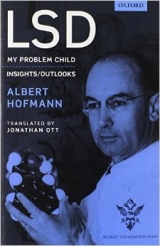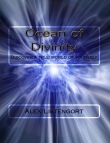
Текст книги "LSD — My Problem Child"
Автор книги: Albert Gofmann
Жанр:
Биографии и мемуары
сообщить о нарушении
Текущая страница: 2 (всего у книги 11 страниц)
Extended, systematic analytical investigations of the supposed ergotoxine mixture led ultimately to the separation of this alkaloidal preparation into three homogeneous components. One of the three chemically homogeneous ergotoxine alkaloids proved to be identical with an alkaloid isolated shortly before in the production department, which A.
Stoll and E. Burckhardt had named ergocristine. The other two alkaloids were both new.
The first I named ergocornine; and for the second, the last to be isolated, which had long remained hidden in the mother liquor, I chose the name ergokryptine (kryptos = hidden).
Later it was found that ergokryptine occurs in two isomeric forms, which were differentiated as alfa– and beta-ergokryptine.
The solution of the ergotoxine problem was not merely scientifically interesting, but also had great practical significance. A valuable remedy arose from it. The three hydrogenated ergotoxine alkaloids that I produced in the course of these investigations, dihydroergocristine, dihydroergokryptine, and dihydroergocornine, displayed medicinally useful properties during testing by Professor Rothlin in the pharmacological department.
From these three substances, the pharmaceutical preparation Hydergine was developed, a medicament for improvement of peripheral circulation and cerebral function in the control of geriatric disorders. Hydergine has proven to be an effective remedy in geriatrics for these indications. Today it is Sandoz's most important pharmaceutical product.
Dihydroergotamine, which I likewise produced in the course of these investigations, has also found application in therapeutics as a circulation– and blood-pressure-stabilizing medicament, under the trade name Dihydergot.
While today research on important projects is almost exclusively carried out as teamwork, the investigations on ergot alkaloids described above were conducted by myself alone. Even the further chemical steps in the evolution of commercial preparations remained in my hands—that is, the preparation of larger specimens for the clinical trials, and finally the perfection of the first procedures for mass production of Methergine, Hydergine, and Dihydergot. This even included the analytical controls for the development of the first galenical forms of these three preparations: the ampoules, liquid solutions, and tablets. My aides at that time included a laboratory assistant, a laboratory helper, and later in addition a second laboratory assistant and a chemical technician.
Discovery of the Psychic Effects of LSD
The solution of the ergotoxine problem had led to fruitful results, described here only briefly, and had opened up further avenues of research. And yet I could not forget the relatively uninteresting LSD-25. A peculiar presentiment—the feeling that this substance could possess properties other than those established in the first investigations—induced me, five years after the first synthesis, to produce LSD-25 once again so that a sample could be given to the pharmacological department for further tests. This was quite unusual; experimental substances, as a rule, were definitely stricken from the research program if once found to be lacking in pharmacological interest.
Nevertheless, in the spring of 1943, I repeated the synthesis of LSD-25. As in the first synthesis, this involved the production of only a few centigrams of the compound.
In the final step of the synthesis, during the purification and crystallization of lysergic acid diethylamide in the form of a tartrate (tartaric acid salt), I was interrupted in my work by unusual sensations. The following description of this incident comes from the report that I sent at the time to Professor Stoll:
Last Friday, April 16,1943, I was forced to interrupt my work in the laboratory in the middle of the afternoon and proceed home, being affected by a remarkable restlessness, combined with a slight dizziness. At home I lay down and sank into a not unpleasant intoxicated-like condition, characterized by an extremely stimulated imagination. In a dreamlike state, with eyes closed (I found the daylight to be unpleasantly glaring), I perceived an uninterrupted stream of fantastic pictures, extraordinary shapes with intense, kaleidoscopic play of colors. After some two hours this condition faded away.
This was, altogether, a remarkable experience—both in its sudden onset and its extraordinary course. It seemed to have resulted from some external toxic influence; I surmised a connection with the substance I had been working with at the time, lysergic acid diethylamide tartrate. But this led to another question: how had I managed to absorb this material? Because of the known toxicity of ergot substances, I always maintained meticulously neat work habits. Possibly a bit of the LSD solution had contacted my fingertips during crystallization, and a trace of the substance was absorbed through the skin. If LSD-25 had indeed been the cause of this bizarre experience, then it must be a substance of extraordinary potency. There seemed to be only one way of getting to the bottom of this. I decided on a self-experiment.
Exercising extreme caution, I began the planned series of experiments with the smallest quantity that could be expected to produce some effect, considering the activity of the ergot alkaloids known at the time: namely, 0.25 mg (mg = milligram = one thousandth of a gram) of lysergic acid diethylamide tartrate. Quoted below is the entry for this experiment in my laboratory journal of April 19, 1943.
Self-Experiments
4/19/43 16:20: 0.5 cc of 1/2 promil aqueous solution of diethylamide tartrate orally =
0.25 mg tartrate. Taken diluted with about 10 cc water. Tasteless.
17:00: Beginning dizziness, feeling of anxiety, visual distortions, symptoms of paralysis, desire to laugh.
Supplement of 4/21: Home by bicycle. From 18:00– ca.20:00 most severe crisis. (See special report.)
Here the notes in my laboratory journal cease. I was able to write the last words only with great effort. By now it was already clear to me that LSD had been the cause of the remarkable experience of the previous Friday, for the altered perceptions were of the same type as before, only much more intense. I had to struggle to speak intelligibly. I asked my laboratory assistant, who was informed of the self-experiment, to escort me home. We went by bicycle, no automobile being available because of wartime restrictions on their use. On the way home, my condition began to assume threatening forms.
Everything in my field of vision wavered and was distorted as if seen in a curved mirror.
I also had the sensation of being unable to move from the spot. Nevertheless, my assistant later told me that we had traveled very rapidly. Finally, we arrived at home safe and sound, and I was just barely capable of asking my companion to summon our family doctor and request milk from the neighbors.
In spite of my delirious, bewildered condition, I had brief periods of clear and effective thinking—and chose milk as a nonspecific antidote for poisoning.
The dizziness and sensation of fainting became so strong at times that I could no longer hold myself erect, and had to lie down on a sofa. My surroundings had now transformed themselves in more terrifying ways. Everything in the room spun around, and the familiar objects and pieces of furniture assumed grotesque, threatening forms.
They were in continuous motion, animated, as if driven by an inner restlessness. The lady next door, whom I scarcely recognized, brought me milk—in the course of the evening I drank more than two liters. She was no longer Mrs. R., but rather a malevolent, insidious witch with a colored mask.
Even worse than these demonic transformations of the outer world, were the alterations that I perceived in myself, in my inner being. Every exertion of my will, every attempt to put an end to the disintegration of the outer world and the dissolution of my ego, seemed to be wasted effort. A demon had invaded me, had taken possession of my body, mind, and soul. I jumped up and screamed, trying to free myself from him, but then sank down again and lay helpless on the sofa. The substance, with which I had wanted to experiment, had vanquished me. It was the demon that scornfully triumphed over my will. I was seized by the dreadful fear of going insane. I was taken to another world, another place, another time. My body seemed to be without sensation, lifeless, strange.
Was I dying? Was this the transition? At times I believed myself to be outside my body, and then perceived clearly, as an outside observer, the complete tragedy of my situation. I had not even taken leave of my family (my wife, with our three children had traveled that day to visit her parents, in Lucerne). Would they ever understand that I had not experimented thoughtlessly, irresponsibly, but rather with the utmost caution, an-d that such a result was in no way foreseeable? My fear and despair intensified, not only because a young family should lose its father, but also because I dreaded leaving my chemical research work, which meant so much to me, unfinished in the midst of fruitful, promising development. Another reflection took shape, an idea full of bitter irony: if I was now forced to leave this world prematurely, it was because of this Iysergic acid diethylamide that I myself had brought forth into the world.
By the time the doctor arrived, the climax of my despondent condition had already passed. My laboratory assistant informed him about my self-experiment, as I myself was not yet able to formulate a coherent sentence. He shook his head in perplexity, after my attempts to describe the mortal danger that threatened my body. He could detect no abnormal symptoms other than extremely dilated pupils. Pulse, blood pressure, breathing were all normal. He saw no reason to prescribe any medication. Instead he conveyed me to my bed and stood watch over me. Slowly I came back from a weird, unfamiliar world to reassuring everyday reality. The horror softened and gave way to a feeling of good fortune and gratitude, the more normal perceptions and thoughts returned, and I became more confident that the danger of insanity was conclusively past.
Now, little by little I could begin to enjoy the unprecedented colors and plays of shapes that persisted behind my closed eyes. Kaleidoscopic, fantastic images surged in on me, alternating, variegated, opening and then closing themselves in circles and spirals, exploding in colored fountains, rearranging and hybridizing themselves in constant flux.
It was particularly remarkable how every acoustic perception, such as the sound of a door handle or a passing automobile, became transformed into optical perceptions. Every sound generated a vividly changing image, with its own consistent form and color.
Late in the evening my wife returned from Lucerne. Someone had informed her by telephone that I was suffering a mysterious breakdown. She had returned home at once, leaving the children behind with her parents. By now, I had recovered myself sufficiently to tell her what had happened.
Exhausted, I then slept, to awake next morning refreshed, with a clear head, though still somewhat tired physically. A sensation of well-being and renewed life flowed through me. Breakfast tasted delicious and gave me extraordinary pleasure. When I later walked out into the garden, in which the sun shone now after a spring rain, everything glistened and sparkled in a fresh light. The world was as if newly created. All my senses vibrated in a condition of highest sensitivity, which persisted for the entire day.
This self-experiment showed that LSD-25 behaved as a psychoactive substance with extraordinary properties and potency. There was to my knowledge no other known substance that evoked such profound psychic effects in such extremely low doses, that caused such dramatic changes in human consciousness and our experience of the inner and outer world.
What seemed even more significant was that I could remember the experience of LSD
inebriation in every detail. This could only mean that the conscious recording function was not interrupted, even in the climax of the LSD experience, despite the profound breakdown of the normal world view. For the entire duration of the experiment, I had even been aware of participating in an experiment, but despite this recognition of my condition, I could not, with every exertion of my will, shake off the LSD world.
Everything was experienced as completely real, as alarming reality; alarming, because the picture of the other, familiar everyday reality was still fully preserved in the memory for comparison.
Another surprising aspect of LSD was its ability to produce such a far-reaching, powerful state of inebriation without leaving a hangover. Quite the contrary, on the day after the LSD experiment I felt myself to be, as already described, in excellent physical and mental condition.
I was aware that LSD, a new active compound with such properties, would have to be of use in pharmacology, in neurology, and especially in psychiatry, and that it would attract the interest of concerned specialists. But at that time I had no inkling that the new substance would also come to be used beyond medical science, as an inebriant in the drug scene. Since my self-experiment had revealed LSD in its terrifying, demonic aspect, the last thing I could have expected was that this substance could ever find application as anything approaching a pleasure drug. I failed, moreover, to recognize the meaningful connection between LSD inebriation and spontaneous visionary experience until much later, after further experiments, which were carried out with far lower doses and under different conditions.
The next day I wrote to Professor Stoll the above-mentioned report about my extraordinary experience with LSD-25 and sent a copy to the director of the pharmacological department, Professor Rothlin.
As expected, the first reaction was incredulous astonishment. Instantly a telephone call came from the management; Professor Stoll asked: "Are you certain you made no mistake in the weighing? Is the stated dose really correct?" Professor Rothlin also called, asking the same question. I was certain of this point, for I had executed the weighing and dosage with my own hands. Yet their doubts were justified to some extent, for until then no known substance had displayed even the slightest psychic effect in fraction-of-a-milligram doses. An active compound of such potency seemed almost unbelievable.
Professor Rothlin himself and two of his colleagues were the first to repeat my experiment, with only one-third of the dose I had utilized. But even at that level, the effects were still extremely impressive, and quite fantastic. All doubts about the statements in my report were eliminated.
2. LSD in Animal Experiments and Biological Research
After the discovery of its extraordinary psychic effects, the substance LSD-25, which five years earlier had been excluded from further investigation after the first trials on animals, was again admitted into the series of experimental preparations. Most of the fundamental studies on animals were carried out by Dr. Aurelio Cerletti in the Sandoz pharmacological department, headed by Professor Rothlin.
Before a new active substance can be investigated in systematic clinical trials with human subjects, extensive data on its effects and side effects must be determined in pharmacological tests on animals. These experiments must assay the assimilation and elimination of the particular substance in organisms, and above all its tolerance and relative toxicity. Only the most important reports on animal experiments with LSD, and those intelligible to the layperson, will be reviewed here. It would greatly exceed the scope of this book if I attempted to mention all the results of several hundred pharmacological investigations, which have been conducted all over the world in connection with the fundamental work on LSD in the Sandoz laboratories.
Animal experiments reveal little about the mental alterations caused by LSD because psychic effects are scarcely determinable in lower animals, and even in the more highly developed, they can be established only to a limited extent. LSD produces its effects above all in the sphere of the higher and highest psychic and intellectual functions. It is therefore understandable that specific reactions to LSD can be expected only in higher animals. Subtle psychic changes cannot be established in animals because, even if they should be occurring, the animal could not give them expression. Thus, only relatively heavy psychic disturbances, expressing themselves in the altered behavior of research animals, become discernible. Quantities that are substantially higher than the effective dose of LSD in human beings are therefore necessary, even in higher animals like cats, dogs, and apes.
While the mouse under LSD shows only motor disturbances and alterations in licking behavior, in the cat we see, besides vegetative symptoms like bristling of the hair (piloerection) and salivation, indications that point to the existence of hallucinations. The animals stare anxiously in the air, and instead of attacking the mouse, the cat leaves it alone or will even stand in fear before the mouse. One could also conclude that the behavior of dogs that are under the influence of LSD involves hallucinations. A caged community of chimpanzees reacts very sensitively if a member of the tribe has received LSD. Even though no changes appear in this single animal, the whole cage gets in an uproar because the LSD chimpanzee no longer observes the laws of its finely coordinated hierarchic tribal order.
Of the remaining animal species on which LSD was tested, only aquarium fish and spiders need be mentioned here. In the fish, unusual swimming postures were observed, and in the spiders, alterations in web building were apparently produced by LSD. At very low optimum doses the webs were even better proportioned and more exactly built than normally: however, with higher doses, the webs were badly and rudimentarily made.
How Toxic Is LSD?
The toxicity of LSD has been determined in various animal species. A standard for the toxicity of a substance is the LD50, or the median lethal dose, that is, the dose with which 50 percent of the treated animals die. In general it fluctuates broadly, according to the animal species, and so it is with LSD. The LD50 for the mouse amounts to 50-60 mg/kg.
i.v. (that is, 50 to 60 thousandths of a gram of LSD per kilogram of animal weight upon injection of an LSD solution into the veins). In the rat the LD50 drops to 16.5 mg/kg, and in rabbits to 0.3 mg/kg. One elephant given 0.297 g of LSD died after a few minutes. The weight of this animal was determined to be 5,000 kg, which corresponds to a lethal dose of 0.06 mg/kg (0.06 thousandths of a gram per kilogram of body weight). Because this involves only a single case, this value cannot be generalized, but we can at least deduce from it that the largest land animal reacts proportionally very sensitively to LSD, since the lethal dose in elephants must be some 1,000 times lower than in the mouse. Most animals die from a lethal dose of LSD by respiratory arrest.
The minute doses that cause death in animal experiments may give the impression that LSD is a very toxic substance. However, if one compares the lethal dose in animals with the effective dose in human beings, which is 0.0003-0.001 mg/kg (0.0003 to 0.001
thousandths of a gram per kilogram of body weight), this shows an extraordinarily low toxicity for LSD. Only a 300– to 600-fold overdose of LSD, compared to the lethal dose in rabbits, or fully a 50,000– to 100,000fold overdose, in comparison to the toxicity in the mouse, would have fatal results in human beings. These comparisons of relative toxicity are, to be sure, only understandable as estimates of orders of magnitude, for the determination of the therapeutic index (that is, the ratio between the effective and the lethal dose) is only meaningful within a given species. Such a procedure is not possible in this case because the lethal dose of LSD for humans is not known. To my knowledge, there have not as yet occurred any casualties that are a direct consequence of LSD
poisoning. Numerous episodes of fatal consequences attributed to LSD ingestion have indeed been recorded, but these were accidents, even suicides, that may be attributed to the mentally disoriented condition of LSD intoxication. The danger of LSD lies not in its toxicity, but rather in the unpredictability of its psychic effects.
Some years ago reports appeared in the scientific literature and also in the lay press, alleging that damage to chromosomes or the genetic material had been caused by LSD.
These effects, however, have been observed in only a few individual cases. Subsequent comprehensive investigations of a large, statistically significant number of cases, however, showed that there was no connection between chromosome anomalies and LSD
medication. The same applies to reports about fetal deformities that had allegedly been produced by LSD. In animal experiments, it is indeed possible to induce fetal deformities through extremely high doses of LSD, which lie well above the doses used in human beings. But under these conditions, even harmless substances produce such damage.
Examination of reported individual cases of human fetal deformities reveals, again, no connection between LSD use and such injury. If there had been any such connection, it would long since have attracted attention, for several million people by now have taken LSD.
Pharmacological Properties of LSD
LSD is absorbed easily and completely through the gastrointestinal tract. It is therefore unnecessary to inject LSD, except for special purposes. Experiments on mice with radioactively labeled LSD have established that intravenously injected LSD disappeared down to a small vestige, very rapidly from the bloodstream and was distributed throughout the organism. Unexpectedly, the lowest concentration is found in the brain. It is concentrated here in certain centers of the midbrain that play a role in the regulation of emotion. Such findings give indications as to the localization of certain psychic functions in the brain.
The concentration of LSD in the various organs attains maximum values 10 to 15
minutes after injection, then falls off again swiftly. The small intestine, in which the concentration attains the maximum within two hours, constitutes an exception. The elimination of LSD is conducted for the most part (up to some 80 percent) through the intestine via liver and bile. Only 1 to 10 percent of the elimination product exists as unaltered LSD; the remainder is made up of various transformation products.
As the psychic effects of LSD persist even after it can no longer be detected in the organism, we must assume that LSD is not active as such, but that it rather triggers certain biochemical, neurophysiological, and psychic mechanisms that provoke the inebriated condition and continue in the absence of the active principle.
LSD stimulates centers of the sympathetic nervous system in the midbrain, which leads to pupillary dilatation, increase in body temperature, and rise in the blood-sugar level.
The uterine-constricting activity of LSD has already been mentioned.
An especially interesting pharmacological property of LSD, discovered by J. H.
Gaddum in England, is its serotonin-blocking effect. Serotonin is a hormone-like substance, occurring naturally in various organs of warm-blooded animals. Concentrated in the midbrain, it plays an important role in the propagation of impulses in certain nerves and therefore in the biochemistry of psychic functions. The disruption of natural functioning of serotonin by LSD was for some time regarded as an explanation of its psychic effects. However, it was soon shown that even certain derivatives of LSD
(compounds in which the chemical structure of LSD is slightly modified) that exhibit no hallucinogenic properties, inhibit the effects of serotonin just as strongly, or yet more strongly, than unaltered LSD. The serotonin-blocking effect of LSD thus does not suffice to explain its hallucinogenic properties.
LSD also influences neurophysiological functions that are connected with dopamine, which is, like serotonin, a naturally occurring hormone-like substance. Most of the brain centers receptive to dopamine become activated by LSD, while the others are depressed.
As yet we do not know the biochemical mechanisms through which LSD exerts its psychic effects. Investigations of the interactions of LSD with brain factors like serotonin and dopamine, however, are examples of how LSD can serve as a tool in brain research, in the study of the biochemical processes that underlie the psychic functions.
3. Chemical Modifications of LSD
When a new type of active compound is discovered in pharmaceutical-chemical research, whether by isolation from a plant drug or from animal organs, or through synthetic production as in the case of LSD, then the chemist attempts, through alterations in its molecular structure, to produce new compounds with similar, perhaps improved activity, or with other valuable active properties. We call this process a chemical modification of this type of active substance. Of the approximately 20,000 new substances that are produced annually in the pharmaceutical-chemical research laboratories of the world, the overwhelming majority are modification products of proportionally few types of active compounds. The discovery of a really new type of active substance—new with regard to chemical structure and pharmacological effect—is a rare stroke of luck.
Soon after the discovery of the psychic effects of LSD, two coworkers were assigned to join me in carrying out the chemical modification of LSD on a broader basis and in further investigations in the field of ergot alkaloids. The work on the chemical structure of ergot alkaloids of the peptide type, to which ergotamine and the alkaloids of the ergotoxine group belong, continued with Dr. Theodor Petrzilka. Working with Dr. Franz Troxler, I produced a great number of chemical modifications of LSD, and we attempted to gain further insights into the structure of lysergic acid, for which the American researchers had already proposed a structural formula. In 1949 we succeeded in correcting this formula and specifying the valid structure of this common nucleus of all ergot alkaloids, including of course LSD.
The investigations of the peptide alkaloids of ergot led to the complete structural formulas of these substances, which we published in 1951. Their correctness was confirmed through the total synthesis of ergotamine, which was realized ten years later in collaboration with two younger coworkers, Dr. Albert J. Frey and Dr. Hans Ott. Another coworker, Dr. Paul A. Stadler, was largely responsible for the development of this synthesis into a process practicable on an industrial scale. The synthetic production of peptide ergot alkaloids using lysergic acid obtained from special cultures of the ergot fungus in tanks has great economic importance. This procedure is used to produce the starting material for the medicaments Hydergine and Dihydergot.
Now we return to the chemical modifications of LSD. Many LSD derivatives were produced, since 1945, in collaboration with' Dr. Troxler, but none proved hallucinogenically more active than LSD. Indeed, the very closest relatives proved themselves essentially less active in this respect.
There are four different possibilities of spatial arrangement of atoms in the LSD
molecule. They are differentiated in technical language by the prefix iso– and the letters D and L. Besides LSD, which is more precisely designated as D-lysergic acid diethylamide, I have also produced and likewise tested in self-experiments the three other spatially different forms, namely D-isolysergic acid diethylamide (iso-LSD), L-lysergic acid diethylamide (L-LSD), and L-isolysergic acid diethylamide (L-iso-LSD). The last three forms of LSD showed no psychic effects up to a dose of 0.5 mg, which corresponds to a 20-fold quantity of a still distinctly active LSD dose.
A substance very closely related to LSD, the monoethylamide of lysergic acid (LAE-23), in which an ethyl group is replaced by a hydrogen atom on the diethylamide residue of LSD, proved to be some ten times less psychoactive than LSD. The hallucinogenic effect of this substance is also qualitatively different: it is characterized by a narcotic component. This narcotic effect is yet more pronounced in lysergic acid amide (LA-111), in which both ethyl groups of LSD are displaced by hydrogen atoms. These effects, which I established in comparative self-experiments with LA-111 and LAE-32, were corroborated by subsequent clinical investigations.
Fifteen years later we encountered lysergic acid amide, which had been produced synthetically for these investigations, as a naturally occurring active principle of the Mexican magic drug ololiuqui. In a later chapter I shall deal more fully with this unexpected discovery.
Certain results of the chemical modification of LSD proved valuable to medicinal research; LSD derivatives were found that were only weakly or not at all hallucinogenic, but instead exhibited other effects of LSD to an increased extent. Such an effect of LSD
is its blocking effect on the neurotransmitter serotonin (referred to previously in the discussion of the pharmacological properties of LSD). As serotonin plays a role in allergic-inflammatory processes and also in the generation of migraine, a specific serotonin-blocking substance was of great significance to medicinal research. We therefore searched systematically for LSD derivatives without hallucinogenic effects, but with the highest possible activity as serotonin blockers. The first such active substance was found in bromo-LSD, which has become known in medicinal-biological research under the designation BOL-148. In the course of our investigations on serotonin antagonists, Dr. Troxler produced in the sequel yet stronger and more specifically active compounds. The most active entered the medicinal market as a medicament for the treatment of migraine, under the trademark "Deseril" or, in English-speaking countries,








